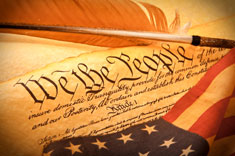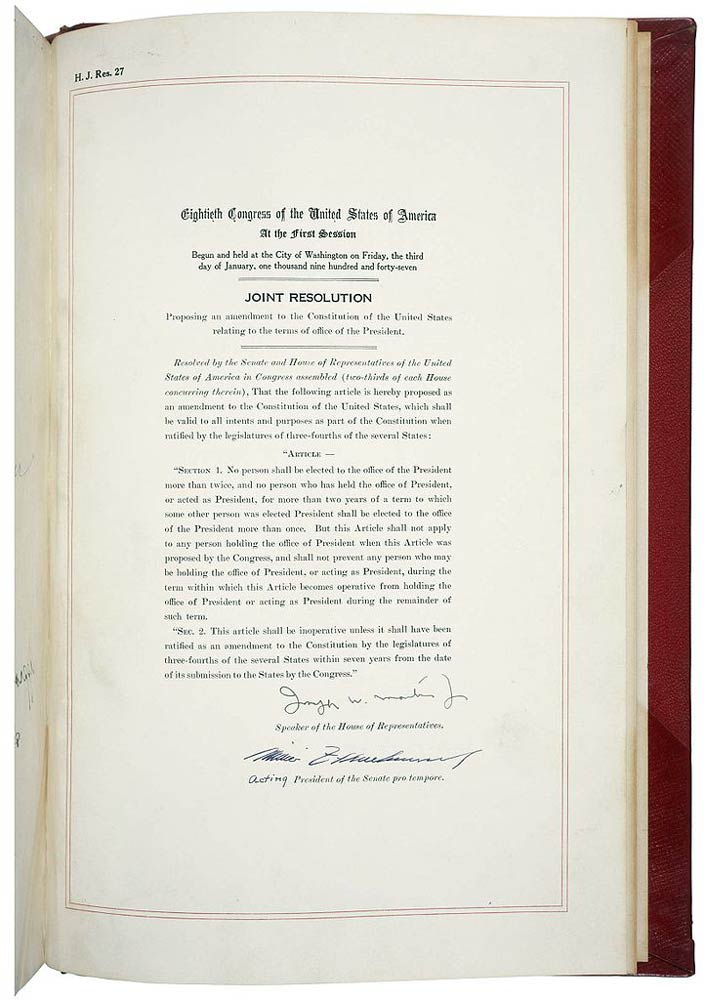| United States Constitution | |
|---|---|
 |
|
| The U.S. Constitution | |
| Preamble | |
| Articles of the Constitution | |
| I ‣ II ‣ III ‣ IV ‣ V ‣ VI ‣ VII | |
| Amendments to the Constitution | |
| Bill of Rights | |
| I ‣ II ‣ III ‣ IV ‣ V ‣ VI ‣ VII ‣ VIII ‣ IX ‣ X | |
| Additional Amendments | |
| XI ‣ XII ‣ XIII ‣ XIV ‣ XV ‣ XVI ‣ XVII ‣ XVIII ‣ XIX ‣ XX ‣ XXI ‣ XXII ‣ XXIII ‣ XXIV ‣ XXV ‣ XXVI ‣ XXVII | |
| View the Full Text | |
| Original Constitution | |
| Bill of Rights | |
| Additional Amendments |
On February 27, 1951, the 22nd Amendment to the Constitution was passed by the U.S. Congress. This amendment aimed to set a limit to the number of terms that an individual could serve as the country’s president. This means that anyone can only become the President up to two times. However, those who have taken over as President during the middle of a term may serve as president up to ten years. The Twenty-second amendment was submitted after President Franklin Roosevelt became a president for four terms. In fact, he broke George Washington’s two terms as president of the United States.
Text
Section 1. No person shall be elected to the office of the President more than twice, and no person who has held the office of President, or acted as President, for more than two years of a term to which some other person was elected President shall be elected to the office of the President more than once. But this article shall not apply to any person holding the office of President when this article was proposed by the Congress, and shall not prevent any person who may be holding the office of President, or acting as President, during the term within which this article becomes operative from holding the office of President or acting as President during the remainder of such term.
Section 2. This article shall be inoperative unless it shall have been ratified as an amendment to the Constitution by the legislatures of three-fourths of the several States within seven years from the date of its submission to the States by the Congress.
Past Presidents of the United States
 According to historians, George Washington did not seek re-election as the U.S president because of his age, which was implied in his Farewell Address. Thomas Jefferson contributed to the proposal of the two-term limit, and his successors adhered to this principle of serving the country as president for a maximum of two terms.
According to historians, George Washington did not seek re-election as the U.S president because of his age, which was implied in his Farewell Address. Thomas Jefferson contributed to the proposal of the two-term limit, and his successors adhered to this principle of serving the country as president for a maximum of two terms.
A few other former presidents also attempted to serve beyond two terms. For instance, Ulysses Grant was said to have sought his third term, yet he lost his nomination to James Garfield. Another president that aimed to seek a third term was Grover Cleveland. However, he did not gain much support during the historical Panic of 1893. Because of this, Cleveland failed to receive support from the Silverites, which was led by William Bryan.
Theodore Roosevelt assumed presidency after William McKinley was assassinated. He was then elected as president in 1940, and he sought for another term in 1912. Unfortunately, he lost the position to Woodrow Wilson. After Wilson has served as president on his first and second terms, he tried to get another term and blocked the nomination of William Gibbs McAdoo. He was not successful in his goal of getting his third term because James M. Cox was nominated instead.
Franklin Roosevelt became the only U.S president that was elected to his third term. In the 1944 presidential election, Roosevelt won another term, yet he suffered from a cerebral hemorrhage that caused his death the following year.
About the 22nd Amendment
According to the amendment, a person may not be elected as president more than two times. Moreover, no individual who has acted as a president for over two years may be allowed to assume presidency more than once. However, this article does not apply to those who hold the office of President when Congress proposed the article.
In the second section, it states that the article remains inoperative unless ratified as amendment to the U.S Constitution. This ratification shall be made by the state legislatures of three-fourths of the states. Moreover, Congress must make the ratification within seven years upon the submission date of the amendment.
This amendment did not apply to Harry Truman, who was the President when the U.S. Congress proposed the 22nd amendment. President Truman served almost all of the unexpired fourth term of Franklin Roosevelt. Furthermore, he was elected to his full term in 1948, and he only withdrew his candidacy for re-election after his loss at the New Hampshire primary.
Impact of the Amendment
Since the ratification of the twenty-second amendment, several presidents have been elected at least twice. The U.S. Presidents who served for two terms included Richard Nixon, Bill Clinton, Dwight Eisenhower, Barack Obama, Ronald Reagan, and George Bush. Lyndon Johnson was the only president of the United States who could have served his term for over eight years. He became the president after the assassination of John F. Kennedy and served the last 14 months of Kennedy’s term. If he did not withdraw his candidacy in 1968, he would have been able to serve another term as president. Gerald Ford was elected president in 1974, and he served the remaining 29 months of Nixon’s unexpired term.
At present, only a few qualified Americans were prohibited from assuming presidency under the terms of the twenty-second amendment. These U.S presidents include George Bush, Barack Obama and Bill Clinton. Supporters of the amendment believe that the two-term limit provides several benefits. Presidents will be less likely to be interested in handing out political favors such as subsidies and grants just to get re-elected for another term. However, others believe that the president’s power may be less limited in his second term since he no longer worried about being eligible to run for office again.